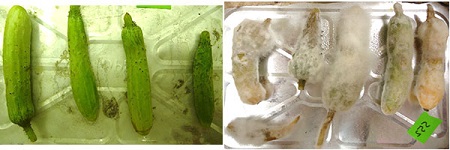Cucumis sativus
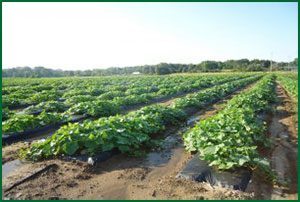
Image provided by R. Grumet, Michigan State University.
Cucumber breeding and genetics
Cucumber Breeding Team
- Yiqun Weng, Yiqun.weng@ars.usda.gov, USDA-ARS , University of Wisconsin – (team leader)
- Rebecca Grumet, grumet@msu.edu
Cucumber breeding and genetics
Cucumber, Cucumis sativus var. sativus, was originated in the Southern Asia Continent, where highly diverse wild as well as cultivated forms are found. Secondary centers of diversity for cucumber exist in China and the Near East. Modern cucumber was domesticated from its wild relative, C. sativus var. hardwickii, that is found wildly in India and several Southeast Asian countries like Thailand, Vietnam and Laos.
The U.S. National Plant Germplasm System holds 1320 C. sativus var. sativus and var. hardwickii accessions including elite cultivars, breeding lines, heirloom varieties, collections from the centers of diversity, and exchange accessions from other collections. Molecular marker analysis of 3000 worldwide cucumber accessions by Lv et al. (2009) revealed three distinct populations: Population 1 includes germplasm from East Asian excluding for the semi-wild Xishuangbanna cucumber; Population 2 includes those from Eurasia and Americas, and Population 3 includes germplasm from India and Xishuangbanna of Southwest China. Indian cucumbers have the highest genetic diversity.
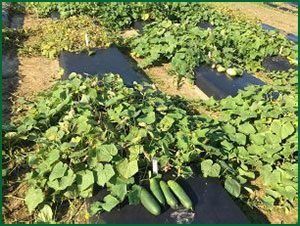
Field plots testing resistance to downy mildew, with some showing good quality of pickling or slicing type fruit. Image provided by T. Wehner
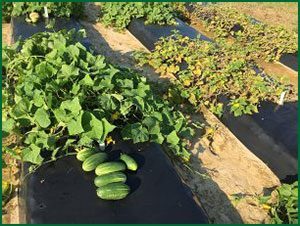
Cucumber breeding lines resistant (left) and susceptible (right) to downy mildew. Image provided by T. Wehner, NC State University.
Downy Mildew
Cucumber downy mildew, caused by Pseudoperonospora cubensis, is a foliar disease of cucumber. Prior to 2004, the disease was controlled through a single recessive gene, dm-1, identified in a cucumber PI accession collected in India (PI 197087) (van Vliet and Meysing 1974). After 2004, the dm-1 gene was less effective in maintaining resistance to the pathogen in US production regions. Additional sources of resistance have been identified in several cucumber accessions originated from India and Pakistan including 197085, PI 330628, PI 197088 and PI 605996. However, each of these sources of resistance have undesirable fruit quality traits for slicing, pickling and European greenhouse markets (Criswell et al. 2010; Call et al. 2012). Among the PI lines examined, PI 330628 and PI 605996 were more resistant longer in the season than other cultigens (VandenLangenberg and Wehner 2016). Their overall vigor and large plant size may give them the ability to outgrow the disease. It is concerning that the resistant accession PI 197088 appears to develop disease symptoms faster than other resistant PI accessions since it is currently being used for the development of commercial cultivars with high levels of resistance.
Quantitative trait loci (QTL) for downy mildew resistance have been identified in several PI lines. Yoshioka et al. (2014) conducted QTL mapping for DM resistance in the cucumber line CS-PMR1 (DM resistance from PI 197088) and identified 11 QTLs in 4 chromosomes (1, 3, 5 and 6) with the major-effect QTL contributed by PI 107088 being located in Chr5. Szczechura et al. (2015) identified three DM resistance QTL in Chr5 from PI 197085. Wang et al. (2016) identified four DM resistance QTL in PI 330628 (WI7120) including dm2.1, dm4.1, dm5.1 and dm6.1. Among them, dm4.1 and dm5.1 are major-effect QTL with only additive effects; dm2.1 and dm6.1 had moderate and minor effects, respectively. More extensive characterization of the genetic basis of DM resistance in PI 197088 is underway.
Breeding objectives
- Fine mapping of major-effect DM resistance QTL from WI7120 (PI 330628). Develop molecular markers for these major-effect QTL adapted to high throughput genotyping.
- Introgress major-effect DM resistance QTL from WI7120 into elite genetic backgrounds of US pickling and beit alpha type cucumbers with marker-assisted selection. Evaluate performance of DM resistance and horticultural traits in advanced backcross lines. Release germplasm with high level of DM resistance.
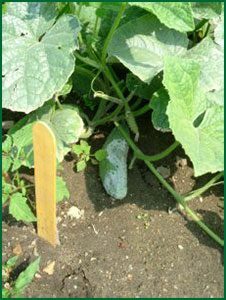
Cucumber fruit infected by Phytophthora capsici. Image provided by R. Grumet.
Phytophthora fruit rot
Phytophthora fruit rot caused by the oomycete pathogen Phytophthora capsici, is a serious disease in field-grown cucumbers. Small, dark, water soaked lesions develop on infected fruit, eventually encompassing the whole fruit with white sporangia. Fruits are the most highly susceptible part of the plant. The disease reduces yield in the field, and, if infected cucumbers are not detected early, can also spoil shipments after harvest.
An age-related resistance was detected during the course of screening a cucumber core collection for resistance, wherein young fruit are highly susceptible but become resistant as they reach full size (Gevens et al 2006). More recently, screening of the full U.S. cucumber PI collection led to identification of three possible sources of young fruit resistance, PIs 109483, 178884, and 214049 (Colle et al. 2014).
Breeding objectives
- Release cucumber germplasm with young fruit resistance to P. capsici, initiate introgression into commercially useful lines, characterize inheritance and identify QTL associated with young fruit resistance
- Determine genetic and physiological basis for age-related resistance to P. capsici. Identify QTL associated with age-related resistance.
- Cucumber variety Poinsett exhibiting age related resistance to P. capsici. Grummet
- Young cucumber fruit resistant (left) and susceptible (right) to P. capsici. Images provided by R. Grumet., Michigan State University.
Literature Cited
- Call A.D., A.D. Criswell, T.C. Wehner, U. Klosinska, and E.U. Kozik. Screening cucumber for resistance to downy mildew caused by Pseudoperonospora cubensis (Berk. and Curt.) Rostov. Crop Science 2012; 52:577-592.
- Cohen, Y., K.M. VandenLangenberg, T.C. Wehner, P.S. Ojiambo, M. Hausbeck, L.M. Quesada-Ocampo, A. Lebeda, H. Sierotzki, and U. Gisi. 2015. Resurgence of Pseudoperonospora cubensis: the causal agent of cucurbit downy mildew. Phytophathology 105: 998-1012.
- Colle M., E.N. Straley, S.B. Makela, S.A. Hammar, R. Grumet. Screening the cucumber plant introduction collection for young fruit resistance to Phytophthora capsici. HortScience 2014; 49:244-249.
- Criswell A.D., A.D. Call, and T.C. Wehner. Genetic control of downy mildew resistance in cucumber – A review. Cucurbit Genetics Cooperative Report 2010; 33-34:13-16.
- Gevens A.J., K. Ando, K.H. Lamour, R. Grumet., and M.K Hausbeck. A detached cucumber fruit method to screen for resistance to Phytophthora capsici and effect of fruit age on susceptibility to infection. Plant Disease 2006; 90:1276-1282.
- Grumet, R. and M. Colle. 2017. Cucumber (Cucumis sativus) breeding line with young fruit resistance to infection by Phytophthora capsici. HortScience (in press)
- Lv J., J. Qi, Q. Shi, D. Shen, S. Zhang, G. Shao, et al. Genetic diversity and population structure of cucumber (Cucumis sativus L.). PLOS One 2012; DOI: 10.1371/journal.pone. 0046919
- Szczechura W., M. Staniaskzek, U. Klosinska, and E.U. Kozik. Molecular analysis of new sources of resistance to Pseudoperonospora cubensis (Berk. et. Curt.) Rostovzev in cucumber. Russian Journal of Genetics 2015; 51:974-979.
- van Vliet G.J.A., and W.D. Meysing. Inheritance of resistance to Pseudoperonospora cubensis Rost. in cucumber (Cucumis sativus L.). Euphytica 1974; 23:251-255.
- VandenLangenberg, K., and T.C. Wehner. 2016. Downy mildew disease progress in resistant and susceptible cucumbers tested in the field at different growth stages. HortScience 51: 984-988.
- Wang, Y., K. VandenLangenberg, T.C. Wehner, P.A.G. Kraan, J. Suelmann, X. Zheng, K. Owens, and Y. Weng. 2016. QTL mapping for downy mildew resistance in cucumber inbred line WI7120 (PI 330628). Theor. Appl. Genet. 129:1493–1505.

